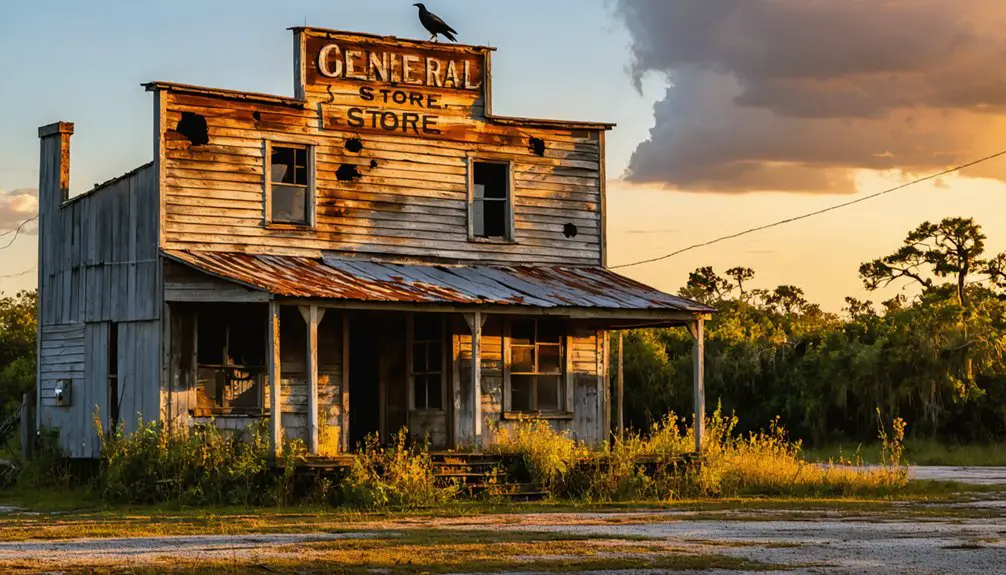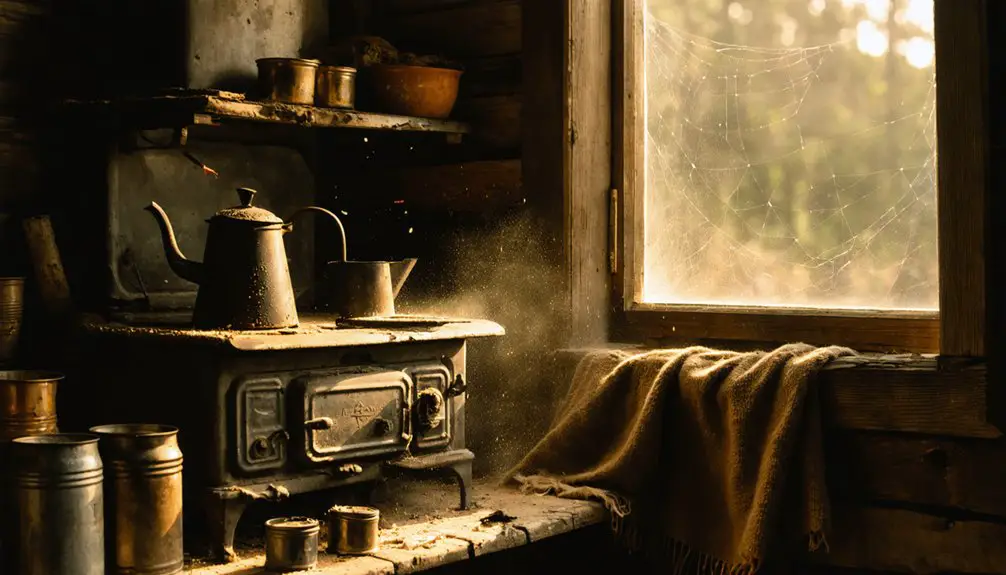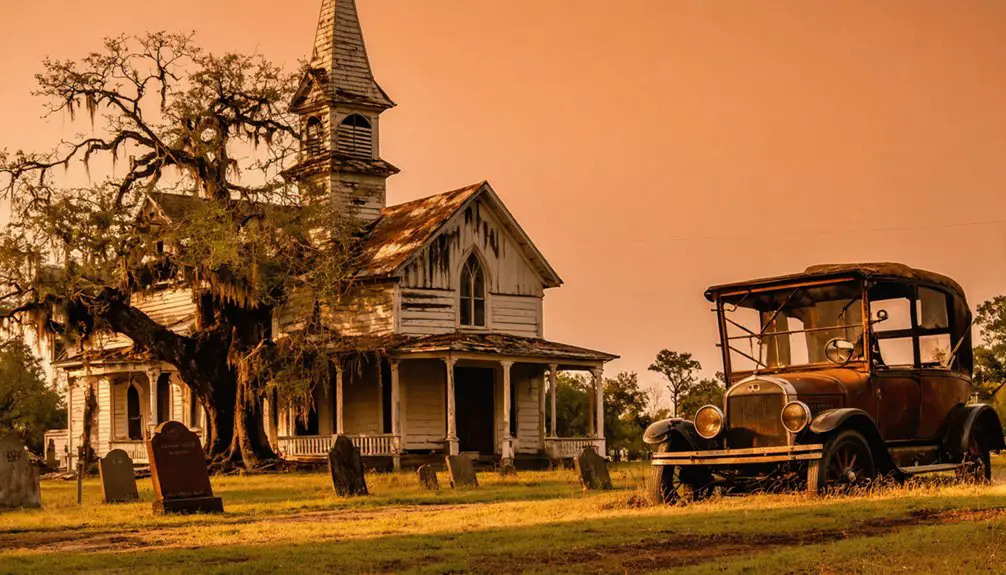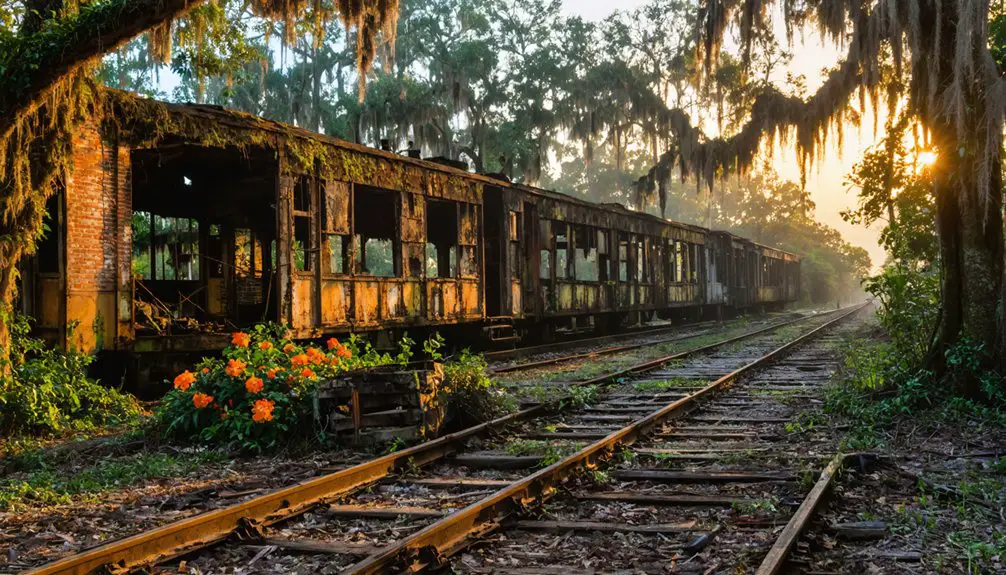You’ll find Stanton’s story in Florida’s post-Civil War railroad expansion, where it emerged as a crucial transport hub supporting local agriculture and timber industries. The town thrived initially but faced decline when resource depletion and competition from nearby cities sparked community migration. Natural disasters, lack of railroad access, and the closure of essential services like the post office sealed its fate. The town’s transformation from bustling settlement to ghost town holds deeper lessons about frontier life.
Key Takeaways
- Stanton emerged during post-Civil War railroad expansion in northern Florida but declined when transportation routes changed and resources depleted.
- Economic decline accelerated after losing railroad access, which isolated the town from major trade routes.
- Natural disasters and fires damaged important buildings, with insufficient funds for repairs leading to infrastructure deterioration.
- The closure of essential services, including the post office, made daily life unsustainable and forced residents to leave.
- Stanton represents Florida’s frontier ghost towns, where transportation changes and economic hardships led to community abandonment.
The Rise of Antelope Station
While many Florida settlements emerged organically through gradual population growth, Antelope Station’s birth was inextricably linked to the expansion of post-Civil War railroad networks in northern Florida.
Antelope Station exemplifies how Florida’s post-Civil War railroad expansion birthed instant communities along strategic transportation routes.
You’ll find its origins deeply rooted in the strategic placement along crucial transportation routes that served the region’s growing needs for trade and commerce.
The settlement’s railroad infrastructure became a lifeline for the area, creating economic connections between isolated rural communities and larger urban centers.
As trains brought steady streams of passengers and freight through the station, you’d have seen a bustling community take shape, much like the growth that would later occur around Cape Canaveral Station when it was established in 1949.
Much like the growing Cuban population that rose from 40,000 to 250,000 between 1790 and 1820, the town saw rapid demographic changes as industry expanded.
Local agriculture and timber industries flourished, while essential services sprouted up to support railroad workers and travelers, including general stores and boarding houses.
Gold Discovery and Mining Boom
A major error appears in the provided historical context – the article title references Stanton, Florida, but the facts discuss Stanton, Arizona.
The 1863 gold discovery near what would become Stanton, Arizona, sparked an intense gold rush that transformed Antelope Creek from a simple prospecting camp into a bustling mining town. Under the influence of Charles P. Stanton, the town gained a reputation for extreme lawlessness.
You’ll find that the area’s rich deposits came from eroded gold-bearing quartz veins around Rich Hill. The discovery of nuggets like potatoes by Mexican prospectors led to the area being nicknamed “Potato Patch.”
By the 1890s, you’d have seen substantial mining infrastructure develop, including a stamp mill for processing ore, alongside the essential elements of frontier life – general stores, hotels, and saloons.
Both placer mining techniques and lode mining operations drew diverse populations to the area.
The post office’s establishment in the late 19th century marked Stanton’s evolution from a temporary camp into a legitimate mining community.
Chuck Stanton’s Infamous Legacy

Despite the town bearing his name, Charles P. “Chuck” Stanton cast a dark shadow over the Arizona mining settlement through his ruthless reign of terror in the 1880s.
You’ll find that Stanton’s tyranny shaped every aspect of local life until his violent end in 1886, when the Lucero brothers gunned him down in his own store.
His legacy of violence left an indelible mark on the town’s history:
- He orchestrated murders of business competitors, including George Wilson and William Partridge.
- His hotel became notorious for wild, drunken orgies and violent gatherings.
- Even after his death, his influence continued as subsequent merchants who tried to run his store met violent ends.
The town, unable to shake its reputation for lawlessness, eventually became a ghost town by 1906, forever haunted by Stanton’s infamous rule. His early life as an illegitimate Irish lord’s son foreshadowed his later descent into criminality and violence. Like many Fort Stanton settlements of the era, the town’s fate was sealed by its violent past.
Stanton Institute: Pioneering Black Education
You’ll find the origins of Stanton Institute deeply rooted in the post-Civil War era, when the Freedmen’s Bureau provided $16,000 to establish Florida’s first secondary school for Black children.
The original 24-acre campus, purchased for $850 from Ossian B. Hart and his wife in 1869, became a symbol of educational resilience as it rose from the ashes of multiple fires, including the devastating 1901 Great Fire of Jacksonville. The school broke new ground by offering education through high school diploma, advancing beyond the typical third-grade limit for African-American students at the time.
Through each rebuild, the campus grew stronger, ultimately adopting the phoenix as its symbol—a representation of its enduring spirit and commitment to Black education in Florida. Under the leadership of James Weldon Johnson, who served as principal in 1894, the school continued to champion educational excellence despite challenging conditions.
Historic Freedman’s Bureau Funding
Through the generous support of the Freedman’s Bureau in 1868, Stanton Institute emerged as Florida’s first official African-American school after receiving $16,000 in construction funding.
You’ll find this groundbreaking investment established on land purchased from Ossian B. Hart, transforming into a two-story wooden building dedicated to training African-American women as teachers. Modern visitors should ensure their JavaScript is enabled to access virtual historical tours of the grounds. General Oliver Howard provided crucial leadership as the Bureau’s director in establishing educational initiatives nationwide.
The Freedman’s Bureau’s commitment to African American education manifested in three key ways:
- Dedicating up to two-thirds of its budget toward schools
- Creating a superintendent position to oversee educational programs
- Leasing property to guarantee sustained public education for Black children
Despite strong local opposition and discriminatory laws, the Bureau’s funding helped create an educational foundation that would shape generations of Black educators in post-Civil War Florida.
Campus Growth Through Fire
While Stanton Institute’s educational mission persisted unwaveringly, its physical campus endured multiple devastating fires that shaped its development and symbolism.
You’ll find fire resilience woven into Stanton’s very identity, as the original 1868 wooden structure burned in 1882, only to be rebuilt that same year.
When the Great Jacksonville Fire of 1901 destroyed the second building, the community’s determination led to another reconstruction in 1902. These recurring fires inspired Stanton to adopt the Phoenix as its mascot, representing rebirth and perseverance.
Through each rebuild, you’d witness educational expansion taking hold. The campus grew from its modest beginnings to encompass 24 acres, eventually serving 1,500 students.
Each reconstruction provided opportunities to improve facilities and broaden academic offerings, transforming setbacks into stepping stones for growth.
Daily Life in a Mining Town

You’d find yourself rising before dawn to begin the grueling work of extracting gold using basic tools like pickaxes and shovels, often in dangerous conditions without proper safety equipment.
The physically demanding labor would continue until dusk, with miners facing constant risks from unstable tunnels and accidents in their quest for precious metals.
After the day’s work, you could join other miners at the Opera House or local saloons for gambling, music, and community gatherings that helped ease the hardships of mining life.
Mining Work Conditions
Life in Stanton’s mines demanded extraordinary physical and mental resilience from workers who endured grueling 10-12 hour shifts beginning before dawn.
You’d face constant mining hazards while traversing dark, unstable tunnels with basic hand tools and early mechanical equipment. Labor conditions were brutally harsh, exposing you to toxic gases, flooding risks, and suffocating dust that led to widespread respiratory diseases.
Consider these daily challenges you’d encounter underground:
- Digging and hauling ore by hand or with mule-drawn carts through poorly ventilated shafts
- Working without proper safety regulations, leading to frequent injuries and deaths from cave-ins
- Battling extreme physical fatigue while dealing with the constant threat of methane gas exposure
The lack of medical facilities meant your injuries often went untreated, while company stores kept you trapped in cycles of debt.
Social Activities After Dark
After enduring grueling shifts in the mines, Stanton’s workers sought refuge in the town’s vibrant nightlife, centered around the Opera House and various public venues.
You’d find miners gathering for impromptu musical performances, dances, and card games that helped ease the day’s tensions. Nighttime gatherings often took place around well-lit public buildings or crackling campfires, where communal storytelling and shared meals strengthened bonds between residents.
The town’s outlaw reputation and rugged mining culture influenced these evening activities, with social interactions shaped by the shared experiences of difficult work conditions.
While lighting was limited, you could always count on finding companionship in taverns or at the Opera House, where the community came together to create moments of normalcy in their challenging frontier lives.
The Path to Abandonment
While Stanton’s initial founding in 1881 showed promise as an agricultural settlement, the town’s path to abandonment began taking shape through a combination of economic and infrastructural challenges.
You’d find economic decline setting in as natural resources depleted and nearby cities drew commerce away. Community migration accelerated as younger generations sought opportunities elsewhere, leaving behind an aging population.
Here’s what sealed Stanton’s fate:
- Lack of railroad access isolated the town from major trade routes
- Natural disasters and fires damaged crucial buildings with no funds for repairs
- Closure of essential services like the post office made daily life unsustainable
Preserving a Lost Community’s Story

Despite Stanton’s decline into a ghost town, dedicated preservation efforts now aim to protect its most significant landmark – the Old Stanton High School.
You’ll find Historic Stanton, Inc.’s Board of Trustees leading ambitious restoration plans, transforming Florida’s first African American high school into a $22 million museum and cultural center.
Through community engagement, volunteers have tackled overgrown grounds and debris removal while historical preservation experts assess the structure’s needs.
A vital $2.5 million state grant in 2022 kickstarted the project, though challenges remain after a 2020 roof collapse.
The site, listed on the National Register of Historic Places since 1983, will showcase educational exhibits highlighting notable figures like James Weldon Johnson and document the struggle for educational equity in Jacksonville’s African American community.
Ghost Towns of Florida’s Frontier
The untamed Florida frontier of the 1820s spawned numerous settlements that now exist only in historical records and archaeological remains.
From wilderness to memory, Florida’s frontier settlements of the 1820s stand preserved in dusty archives and buried artifacts.
As you explore Florida’s ghost town characteristics, you’ll find their stories reflect the volatile nature of frontier settlement dynamics, where prosperity could vanish as quickly as it appeared.
- Transportation changes dealt fatal blows to many towns, with railroad bypasses forcing communities like Newnansville to fade into obscurity.
- Natural disasters, particularly the devastating “Big Freeze” of 1894-1895, triggered mass exodus from agricultural settlements across Marion, Lake, and Sumter counties.
- Economic hardships struck when local businesses closed and resources depleted, though some communities lingered with dwindling populations rather than facing complete abandonment.
These abandoned settlements tell a compelling story of frontier life’s fragility and the freedom-seeking pioneers who built them.
Frequently Asked Questions
What Happened to Chuck Stanton After His Reign of Terror Ended?
You’ll find Chuck Stanton’s haunted legacy ended abruptly when he was killed by the Lucero brothers in 1886, shot three times in his store, leaving a violent aftermath that drove the town to abandonment.
Are There Any Remaining Structures From the Original Stanton Institute Today?
You won’t find any architectural remnants from the original 1869 Stanton Institute today. Historical preservation efforts focus on the 1917 brick building that replaced the earlier wooden structure after demolition.
What Specific Gold Mining Techniques Were Used at Stanton’s Mines?
You’ll find they primarily used placer mining with drywashing, sluicing, and panning methods to extract alluvial gold. When water was available, they’d operate stamp mills to crush ore from quartz veins.
Did Any Families From Original Stanton Settlers Remain in Florida?
You’ll find limited evidence of settler descendants or family legacies continuing in Florida from Stanton’s original settlers, though some family lines may persist undocumented in surrounding communities and cemeteries.
What Natural Disasters Affected Stanton Before Its Eventual Abandonment?
You won’t find records of hurricanes, impacts, or flooding history affecting Stanton before abandonment. The only documented disasters were structural fires, including the 1882 school fire and later building deterioration.
References
- https://www.thejaxsonmag.com/article/a-rare-look-inside-historic-old-stanton-school/
- https://www.itsfloridacountry.com/exploring-floridas-best-ghost-towns-and-abandoned-places/
- https://www.jimwitkowski.com/blog/stanton-the-outlaw-ghost-town/
- https://ghosttownadventures.wordpress.com/2018/03/
- https://www.youtube.com/watch?v=jnG0GNI8wZU
- https://www.nps.gov/parkhistory/online_books/bibe/adhi/adhi13b.htm
- https://en.wikipedia.org/wiki/Cape_Canaveral_Space_Force_Station
- https://www.youtube.com/watch?v=LLj3z9LFgIw
- https://exhibits.stanford.edu/ruderman/catalog?f[place_created_ssim][]=n.p.&per_page=24&q=”history”&range[pub_year_tisim][begin]=1850&range[pub_year_tisim][end]=1899&sort=score+desc,+pub_year_isi+desc,+title_sort+asc&view=list
- https://www.rome2rio.com/s/Calexico/Antelope-Valley-California-Poppy-Reserve



